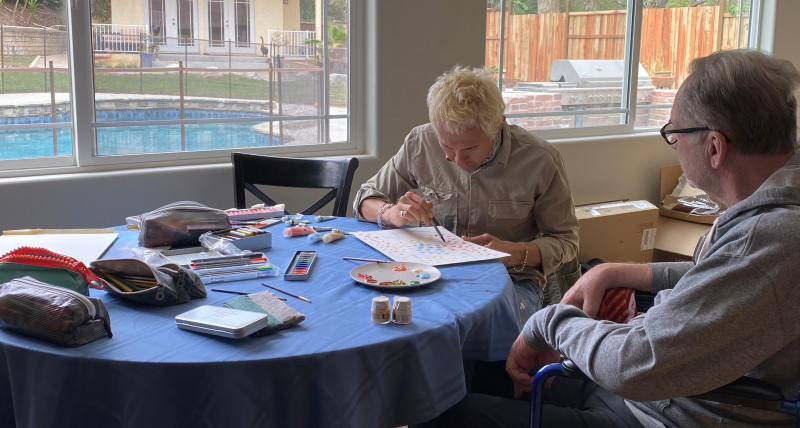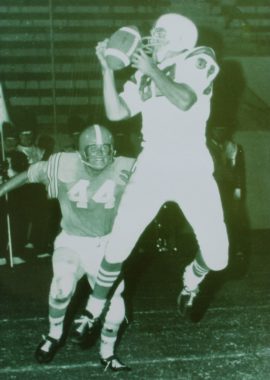Artist With ALS Finds Collaborator, Friend to Paint Through Disease

A gay 39-year-old entrepreneur from Mexico and a retired Jewish football player-turned-bank-CEO in the early stages of amyotrophic lateral sclerosis (ALS) come from different places and are in different stages of life. But through art, Octavio Molina and Ken Brenner have become fast friends, discussing life at its deepest level while collaborating on paintings.
“When we paint, it takes the fear out of what I’m going through,” Brenner said, as ALS continues to rob him of his physical abilities.

An untitled piece from their latest collaboration, “Connecting the Dots.” (Photo courtesy of Octavio Molina and Ken Brenner)
Because Brenner, 74, can no longer hold a paintbrush, he uses his right index finger to paint. So their latest collaboration, “Connecting the Dots,” has embraced Brenner’s ability. He starts the process, laying down dots, while Molina finishes painting and drawing designs that focus on a well-rounded composition — in a sense, reining in Brenner’s creativity to the confines of a canvas.
“He always tells me he’s good at framing my chaos,” Brenner said of Molina in a joint interview with ALS News Today.
They compliment each other in painting and in life despite following very different professional routes. Molina has learned design and beauty in schooling around the world, and is currently the founder and creative director for Tavi Beauty, which focuses on hair care products with a minimalistic design. Brenner, a former Long Beach State University football player, transitioned into banking, finishing his career as the CEO of Avidbank in Palo Alto, California, before ALS forced him to retire.
A ‘mental break’
Brenner and Molina get together almost every weekend at Brenner’s home in Woodland Hills, a suburb of Los Angeles, and spend five to six hours painting per day. Since Brenner moved to the LA area in March, which is also where Molina lives, the two have put out 30 paintings on which they’ve collaborated. Before Brenner moved, they had done 50. When they collaborated last July during the second deadly wave of COVID-19, they worked outside near Brenner’s garage.
“I’ve always loved art since I was 18,” Brenner said. “What I love is the process, and Tavi [Octavio] just extends that process.”

Ken Brenner and Octavio Molina collaborate on a piece before Brenner lost the ability to move his arms. (Photo courtesy of Jordan Brenner)
These sessions are not only filled with paint, they’re also brimming with conversation on a level neither of them can describe. For Brenner, it’s almost like therapy, because during those long stretches of time when art occupies his mind, there’s no room for thoughts about ALS to creep in.
“Art gives me something to focus on,” Brenner said. “I lose myself; I don’t think about my issues. So it’s sort of a mental break.”
When Brenner turned 70, he said his body began to deteriorate. He had stenosis, a condition in which the spaces between the spine and nerves narrow, causing severe back pain and walking difficulties, and was tripping frequently. After testing by neurologists, Brenner was eventually diagnosed, last August, with ALS.
Every week, he says, he loses the ability to do physical activities as his muscles atrophy to the point where he can see the bone. He can no longer move his arms, only his two index fingers, and stands just during wheelchair transfers.
Art is life
Art has been a part of Brenner’s life since a back injury while playing football in college. He ruptured a disk, the spongy material that separates and cushions each of the 33 vertebrae, and couldn’t exercise, so he discovered famous artists and got into acrylic and watercolor painting.
“Injuries always motivated me,” Brenner said.

Ken Brenner catches the ball in a Long Beach State University football game. (Photo courtesy of Jordan Brenner)
After moving to Berkeley as part of the hippie movement, Brenner went back to school to get his teaching credential. During that time he met his wife, to whom he’s been married for 44 years, and shortly thereafter started a family. He later transitioned into banking, rising to the CEO level.
Brenner would paint with his kids when they were younger, but didn’t seriously take up the hobby again until the 2008 financial crisis, when his family encouraged him to go back to it.
He found a mentor, Martha Safra, a representational artist and impressionist, who helped him learn oil painting. Through the connections he made in the banking world, Brenner, with the help of his son Jordan, put on art shows in the Bay Area.
Now Brenner has finally found a collaborator in Molina, whom he met through a mutual friend of Jordan’s. Molina and Jordan went on a trip to New York about six years ago, became close friends, and eventually made the painting connection with Jordan’s father.
On Aug. 14, 2019, Molina and Brenner were in the same art show, titled “Past, Present, and Future.” Their work represented the future of painting. Brenner had to leave before the actual exhibit, without having met Molina, but Jordan later sent him videos of Molina painting.
“I was very attracted to the energy, and his fluidity and his endurance and stamina and creativity,” Brenner said.
Partners in painting
Brenner had been searching for a partner for a while, and the two quickly took an interest in one another’s work. Molina was drawn to Brenner’s liberal application of color, whether in his abstract, nature, or still-life portfolio.
“The interest from my end grew stronger as I had seen how he was using color technique in a very different way than what I was using,” Molina said. “At that time I was using color, but I was not as free as Mr. Brenner was with his color application.”
Part of the hesitancy to use color more freely in his work, Molina says, stemmed from the “macho” culture he encountered growing up in Mexico. It made him feel like he couldn’t be himself. But now, Molina is, in a way, helping Brenner express himself through painting.
“When you’re collaborating, you have to really just become open with yourself and the artists you collaborate with,” Molina said.
Jordan, who sat in on the interview with the two painters, helps sell the collaborative art of Brenner and Molina. He said some of their pieces go for $10,000 to $15,000. All the art is sold directly to customers. While Molina tries not to focus as much on the price, he admits it feels validating to know his and Brenner’s work is valued that highly.
“It does allow you to feel more free to create and appreciate it,” Molina said.
The two also are using their creativity to raise funds for ALS research and care. An upcoming art show on June 26 will benefit the Martha Olsen Fernandez Foundation, which funds research for a cure and provides financial assistance to underserved patients in California’s Central Coast area.
Jordan said the foundation has been a huge help for his family and guided them through the difficult progression of the disease.
Brenner knows that, with ALS, he’ll eventually lose the ability to move his fingers. But Molina will still be there to help him create his art. It’s something the pair already has discussed in their hours-long painting sessions.
“When I can’t paint anymore or use my hand at all, we can really collaborate in terms of I can tell Tavi what I’m seeing or ideas or colors,” Brenner said.
But for now, Brenner is staying strong.
“I’ll paint until I can’t.”






